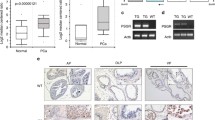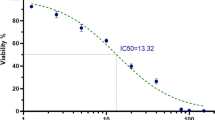Abstract
CpG-oligonucleotides (CpG-ODNs), mimicking bacterial DNA, have recently been shown to stimulate prostate cancer invasion in vitro via Toll-like receptor 9 (TLR9). Since cyclooxygenase 2 (COX-2), frequently overexpressed in multiple tumor types including prostate cancer, is a causal factor for tumor development, invasion and metastasis, an interesting question is raised whether TLR9 regulates COX-2 expression in prostate cancer cells. To address this question, herein we examined COX-2 expression in PC-3 cells stimulated with different doses and time courses of CpG-ODNs. The regulatory role of NF-κB in TLR9-mediated COX-2 expression was also investigated. CpG-ODN was found to up-regulate the expression of COX-2 in PC-3 cells in a dose- and time-dependent manner, but have little impact on COX-1 expression. Moreover, CpG-ODN also promoted nuclear translocation and activation of NF-κB, which appeared to be required for COX-2 induction by CpG-ODN. Overall, TLR9 up-regulates COX-2 expression in prostate cancer cells, at least partially through the activation of NF-κB, which may be implicated in tumor invasion and metastasis.





Similar content being viewed by others

References
Vaidya SA, Cheng G (2003) Toll-like receptors and innate antiviral responses. Curr Opin Immunol 15:402–407. doi:10.1016/S0952-7915(03)00070-0
Akira S, Hemmi H (2003) Recognition of pathogen-associated molecular patterns by TLR family. Immunol Lett 85:85–95. doi:10.1016/S0165-2478(02)00228-6
Wagner H (2004) The immunobiology of the TLR9 subfamily. Trends Immunol 25:381–386. doi:10.1016/j.it.2004.04.011
Chen R, Alvero AB, Silasi DA et al (2008) Cancers take their Toll–the function and regulation of Toll-like receptors in cancer cells. Oncogene 27:225–233. doi:10.1038/sj.onc.1210907
Huang B, Zhao J, Unkeless JC et al (2008) TLR signaling by tumor and immune cells: a double-edged sword. Oncogene 27:218–224. doi:10.1038/sj.onc.1210904
Salaun B, Coste I, Rissoan MC et al (2006) TLR3 can directly trigger apoptosis in human cancer cells. J Immunol 176:4894–4901
Kelly MG, Alvero AB, Chen R et al (2006) TLR-4 signaling promotes tumor growth and paclitaxel chemoresistance in ovarian cancer. Cancer Res 66:3859–3868. doi:10.1158/0008-5472.CAN-05-3948
Huang B, Zhao J, Li H et al (2005) Toll-like receptors on tumor cells facilitate evasion of immune surveillance. Cancer Res 65:5009–5014. doi:10.1158/0008-5472.CAN-05-0784
Merrell MA, Ilvesaro JM, Lehtonen N et al (2006) Toll-like receptor 9 agonists promote cellular invasion by increasing matrix metalloproteinase activity. Mol Cancer Res 4:437–447. doi:10.1158/1541-7786.MCR-06-0007
Andaloussi AE, Sonabend AM, Han Y et al (2006) Stimulation of TLR9 with CpG ODN enhances apoptosis of glioma and prolongs the survival of mice with experimental brain tumors. Glia 54:526–535. doi:10.1002/glia.20401
Droemann D, Albrecht D, Gerdes J et al (2005) Human Lung cancer cells express functionally active Toll-like receptor 9. Respir Res 6:1. doi:10.1186/1465-9921-6-1
Schmausser B, Andulis M, Endrich S et al (2005) Toll-like receptors TLR4, TLR5 and TLR9 on gastric carcinoma cell: an implication for interaction with helicobacter pylori. Int J Med Microbiol 295:179–185. doi:10.1016/j.ijmm.2005.02.009
Kundu SD, Lee C, Billips BK et al (2008) The toll-like receptor pathway: a novel mechanism of infection-induced carcinogenesis of prostate epithelial cells. Prostate 68:223–229. doi:10.1002/pros.20710
Ilvesaro JM, Merrell MA, Swain TM et al (2007) Toll like receptor-9 agonists stimulate prostate cancer invasion in vitro. Prostate 67:774–781. doi:10.1002/pros.20562
Jain S, Chakraborty G, Raja R et al (2008) Prostaglandin E2 regulates tumorangiogenesis in prostate cancer. Cancer Res 68:7750–7759. doi:10.1158/0008-5472.CAN-07-6689
Attiga FA, Fernandez PM, Weeraratna AT et al (2000) Inhibitors of prostaglandin synthesis inhibit human prostate tumor cell invasiveness and reduce the release of matrix metalloproteinases. Cancer Res 60:4629–4637
Nithipatikom K, Isbell MA, Lindholm PF et al (2002) Requirement of cyclooxygenase-2 expression and prostaglandins for human prostate cancer cell invasion. Clin Exp Metastasis 19:593–601. doi:10.1023/A:1020915914376
Pan MR, Hou MF, Chang HC et al (2008) Cyclooxygenase-2 up-regulates CCR7 via EP2/EP4 receptor signaling pathways to enhance lymphatic invasion of breast cancer cells. J Biol Chem 283:11155–11163. doi:10.1074/jbc.M710038200
Gee J, Lee IL, Grossman HB et al (2008) Forced COX-2 expression induces PGE(2) and invasion in immortalized urothelial cells. Urol Oncol 26:641–645. doi:10.1016/j.urolonc.2007.05.015
Sansone P, Piazzi G, Paterini P, et al (2008) Cyclooxygenase-2/Carbonic anhydrase-IX up-regulation promotes invasive potential and hypoxia survival in colorectal cancer cells. J Cell Mol Med. doi:10.1111/j.1582-4934.2008.00580.x
Lee EJ, Choi EM, Kim SR et al (2007) Cyclooxygenase-2 promotes cell proliferation, migration and invasion in U2OS human osteosarcoma cells. Exp Mol Med 39:469–476
N’Guessan PD, Hippenstiel S, Etouem MO et al (2006) Streptococcus pneumoniae induced p38 MAPK- and NF-kappaB-dependent COX-2 expression in human lung epithelium. Am J Physiol Lung Cell Mol Physiol 290:L1131–L1138. doi:10.1152/ajplung.00383.2005
Ikezoe T, Yang Y, Saitoh T et al (2006) PC-SPES down-regulates COX-2 via inhibition of NF-kappaB and C/EBPbeta in non-small cell lung cancer cells. Int J Oncol 29:453–461
Livak KJ, Schmittgen TD (2001) Analysis of relative gene expression data using real-time quantitative PCR and the 2(-Delta Delta C(T)) method. Methods 25:402–408. doi:10.1006/meth.2001.1262
Bernard MP, Phipps RP (2007) CpG oligodeoxynucleotides induce cyclooxygenase-2 in human B lymphocytes: implications for adjuvant activity and antibody production. Clin Immunol 125:138–148. doi:10.1016/j.clim.2007.07.006
Song PI, Park Y-M, Abraham T et al (2002) Human keratinocytes express functional CD14 and toll-like receptor 4. J Invest Dermatol 119:424–432. doi:10.1046/j.1523-1747.2002.01847.x
Wu ZH, Miyamoto S (2007) Many faces of NF-kappaB signaling induced by genotoxic stress. J Mol Med 85:1187–1202. doi:10.1007/s00109-007-0227-9
Cuzzocrea S, Chatterjee PK, Mazzon E et al (2002) Pyrrolidine dithiocarbamate attenuates the development of acute and chronic inflammation. Br J Pharmacol 135:496–510. doi:10.1038/sj.bjp.0704463
Nurmi A, Vartiainen N, Pihlaja R et al (2004) Pyrrolidine dithiocarbamate inhibits translocation of nuclear factor kappa-B in neurons and protects against brain ischaemia with a wide therapeutic time window. J Neurochem 91:755–765. doi:10.1111/j.1471-4159.2004.02756.x
He W, Liu Q, Wang L et al (2007) TLR4 signaling promotes immune escape of human lung cancer cells by inducing immunosuppressive cytokines and apoptosis resistance. Mol Immunol 44:2850–2859. doi:10.1016/j.molimm.2007.01.022
Suzuki R, Yamamoto M, Saka H et al (2009) A phase II study of carboplatin and paclitacel with meloxicam. Lung Cancer 63:72–76. doi:10.1016/j.lungcan.2008.04.002
Mustafa A, Kruger WD (2008) Suppression of tumor formation by a cyclooxygenase-2 inhibitor and a peroxisome proliferator-activated receptor gamma agonist in an in vivo mouse model of spontaneous breast cancer. Clin Cancer Res 14:4935–4942. doi:10.1158/1078-0432.CCR-08-0958
Naugler WE, Karin M (2008) NF-kappaB and cancer-identifying targets and mechanisms. Curr Opin Genet Dev 18:19–26. doi:10.1016/j.gde.2008.01.020
Zha S, Yegnasubramanian V, Nelson WG et al (2004) Cyclooxygenases in cancer: progress and perspective. Cancer Lett 215:1–20. doi:10.1016/j.canlet.2004.06.014
Matsumoto M, Funami K, Tanabe M et al (2003) Subcellular localization of Toll-like receptor 3 in human dendritic cells. J Immunol 171:3154–3162
Heil F, Ahmad-Nejad P, Hemmi H et al (2003) The toll-like receptor 7 (TLR7)-specific stimulus loxoribine uncovers a strong relationship within the TLR7, 8 and 9 subfamily. Eur J Immunol 33:2987–2997. doi:10.1002/eji.200324238
Author information
Authors and Affiliations
Corresponding author
Rights and permissions
About this article
Cite this article
Di, J.M., Pang, J., Sun, Q.P. et al. Toll-like receptor 9 agonists up-regulates the expression of cyclooxygenase-2 via activation of NF-κB in prostate cancer cells. Mol Biol Rep 37, 1849–1855 (2010). https://doi.org/10.1007/s11033-009-9620-5
Received:
Accepted:
Published:
Issue Date:
DOI: https://doi.org/10.1007/s11033-009-9620-5



